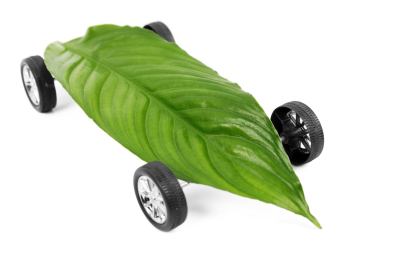
The automobile has been an important part of American life since the dawn of the 20th century. It is an essential part of modern life in that it provides the convenience of transportation on an on-demand and individual basis. There are, however, significant problems that cars pose for society and the environment, which are based on the type of fuel that they use. Cars use fossil fuels, most commonly in the form of diesel and gasoline, and as a result of burning this fuel, they produce pollution. The pollution from cars is not only dangerous to the ecosystem and human health, but it is also a contributor to global warming. In addition, the process of extracting oil and refining it into gasoline contributes further to the overall degradation of the environment. Fossil fuel is also non-renewable, which means it will eventually run out, and all transportation that depends on this natural resource will cease to function. There are, however, solutions to powering transportation vehicles that don't involve the use of fossil fuels. These are called alternative fuel sources, or renewable energy sources, and they include electric power, hybrid-electric systems, ethanol, biodiesel, and hydrogen fuel cells. These sources of power for automobiles are already proven to work, are renewable or readily replenished, and either produce fewer environmentally harmful emissions, or none at all.
Hybrids
Hybrid vehicles have engines that use a combination of two different types of energy to achieve motion. The most common type of hybrid is the hybrid electric vehicle which uses electricity and gasoline, although some trains, buses and older military submarines use diesel-electric hybrid engines. Gasoline-electric hybrid engines work by using the electric-powered motor to augment the performance of the gasoline-powered or internal combustion engine, which allows the car to produce the same amount of performance with a smaller motor. In addition, the electric engine takes over while the internal combustion engine turns off when the car is idling or when the car is driving at slow speeds, which conserves gasoline. When the car brakes, energy from the braking process goes back into the battery in a process called regenerative braking. All of this helps to reduce but not eliminate the amount of gasoline the car burns, and thus it reduces the pollution that it produces.
Electric
Automobiles that run solely using electric motors are called electric vehicles, or EVs. EVs use no internal combustion engine and thus they produce no emissions whatsoever. In order to keep their batteries charged they can also use solar panels to generate electricity whenever they are outside. In addition, they can use charging stations in order to recharge the car's batteries. Recent inventions such as the solar roadway concept, in the future, could provide solar energy to electric cars while they are in motion on the nation's streets and highways.
Ethanol
Ethanol-powered vehicles use a form of biofuel called grain alcohol, which is similar to the alcohol that people drink. The difference is that ethanol for fuel purposes has, at ninety-five percent content by volume or even higher, a much higher alcohol content level than regular alcohol. Ethanol is made from the conversion of plant material into fuel, or a fuel additive. The most common type of plant materials that are useful for ethanol biofuel include sugar and corn, although wheat and potatoes can also be a source of ethanol. Sugar-based ethanol has a higher level of harmful smog emissions reductions than corn-based ethanol. While some engines can run on pure ethanol, most cars use a blend of ethanol and gasoline. Ethanol blends range from classifications called E15, which means that the fuel has 85 percent gasoline and 15 percent ethanol, to E85, which uses 85 percent ethanol.
Hydrogen
Cars that use hydrogen are known as hydrogen internal combustion or hydrogen fuel cell vehicles. Hydrogen internal combustion engines burn hydrogen to create propulsion, although this may generate a small amount of nitrous oxides, which is a greenhouse gas. A hydrogen fuel cell creates energy by reacting hydrogen with oxygen. Due to the nature of mixing oxygen and hydrogen, cars that use fuel cells produce only water for emissions, which means they produce no smog or greenhouse gases.
Biodiesel
Biodiesel is another form of biofuel which primarily uses oil from vegetable or animal fats instead of corn or sugar canes. The difference is that biodiesel-powered vehicles can use fresh or used vegetable oil or animal fat-based grease as a fuel source. Waste vegetable oil from restaurants and fast food establishments, for instance, are useful as fuel for vehicles that use biodiesel. To use this, vehicles must have an engine designed for biodiesel, or they can use filter systems to work with existing diesel engines. On the market, biodiesel is sold as a blended fuel, which means that regular diesel is mixed with biodiesel. The term B100 means that the fuel is one hundred percent biodiesel, while B2 means a two percent mixture of biodiesel and ninety eight percent regular diesel. Biodiesel offers a significant reduction in greenhouse gases and smog compared to gasoline, including carbon monoxide and sulfur-based pollutants called sulfates, particulates, and ozone chemicals, although it increases the output of nitrous oxides.
- US Department of Energy: Alternative Fuels Data Center
- Plug-in Hybrids
- Biodiesel Emissions (PDF)
- Alternative Fuel Vehicles
- National Renewable Energy Laboratory: Fuel Cell Vehicles
- Electric Drive: Vehicle Descriptions
- Union of Concerned Scientists: Fuel-Cell Vehicles
- Ethanol Use in Motor Vehicles
- Fossil Fuels, Ethanol, and Biodiesel
- Clean Fuels: An Overview (PDF)
- Biodiesel Education: What Is Biodiesel?
- Biofuels Indiana: What is Ethanol?
- Hybrid (Gasoline and Electric) Vehicles
- Department of Energy EV Info: How Hybrids Work
- Hydrogen Basics: What Is Hydrogen?
- Hydrogen Powered Transportation
- What Makes Hybrid Cars So Efficient?
By: Walter Zeiss
